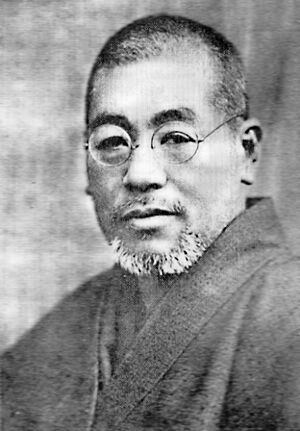Mikao Usui facts for kids
Quick facts for kids
Mikao Usui
|
|
|---|---|

臼井甕男
|
|
| Born | 15 August 1865 Taniai (now called Miyama cho) (Gifu)
|
| Died | 9 March 1926 (aged 60) Fukuyama (福山市)
|
| Nationality | Japanese |
| Occupation | Reiki Master |
| Known for | Reiki |
Mikao Usui (臼井甕男, 15 August 1865 – 9 March 1926) was a Japanese teacher. He is known as the founder of a spiritual practice called Reiki. Reiki is a type of alternative therapy. It is used to help with physical, emotional, and mental well-being.
Usui taught Reiki to more than 2,000 people during his life. Eleven of his students became advanced teachers, known as Master level.
Contents
Mikao Usui's Early Life
Mikao Usui was born on August 15, 1865. This was in a village called Taniai in Japan. Today, this area is near the city of Nagoya. His father's name was Uzaemon. His mother was from the Kawai family.
Usui had two brothers, Sanya and Kuniji. Sanya became a doctor, and Kuniji became a policeman. He also had an older sister named Tsuru. Usui's family, the Chiba clan, were once powerful Hatamoto samurai. A military leader named Tsunetane Chiba was one of Usui's ancestors. In 1551, his family took the name Usui. Mikao Usui was trained in martial arts, like aiki, from a young age.
Some stories in the United States say that Mikao Usui earned a special degree from the University of Chicago. However, research shows he never studied there or received any degree from that university.
Mikao Usui's Work and Teachings
As an adult, Mikao Usui traveled to different countries. He visited places in America, Europe, and China. He studied many subjects, including history, medicine, Buddhism, Christianity, psychology, and Taoism.
Usui's main goal was to teach people how to connect with a "universal life force" energy. This energy was meant to help them grow and develop themselves. What made Usui's teachings special was his use of something called reiju or attunement. This was a way to remind students of their spiritual connection.
All of Usui's students learned five important principles to live by. Those who were very interested became dedicated students. At first, there might not have been a clear difference between people seeking healing and those wanting spiritual lessons. People came to Usui for different reasons.
Shugendō is a Japanese spiritual practice. It involves spending time in mountains and combines ideas from Shinto and Buddhist traditions. People who practice Shugendō often offer religious services. These can include fortune telling, divination, and prayers. They might also perform exorcisms. Families sometimes used Shugendō to help heal illnesses or avoid bad luck.
Hawayo Takata was a Reiki Master who learned from Chujiro Hayashi. She changed some parts of Reiki's history to make it more popular in Western countries. She connected Reiki to Jesus Christ instead of Buddhism. She also falsely said that Usui was the head of a Christian school.
Usui actually learned about Reiki from a Buddhist religious book. But Takata claimed he was inspired by the story of Jesus healing people with his touch. She said he went to America to learn Reiki. She did this to help Reiki spread among Christians. She thought it might disappear otherwise. However, Reiki originally came from Buddhism.
Important Events in the 1920s
In the early 1920s, Usui spent 21 days on Mount Kurama. During this time, he practiced prayer and fasting. Many believe that this is when Usui developed the practice of Reiki. Mount Hiei is a major Buddhist center near Kyoto. It is thought that Usui might have practiced there too if he was a lay priest. His teachings included self-discipline, fasting, and prayer.
In April 1922, Usui opened a place in Tokyo. Here, he taught Reiki and gave treatments. Many people came to him from all over.
In September 1923, a huge earthquake hit Japan. A large fire also broke out. Many people were hurt and in pain. Usui felt sad for them. He went out every morning to help people in the town. He healed and saved many people.
Mikao Usui's Family and Passing
Mikao Usui married Sadako Suzuki. They had two children, a son named Fuji and a daughter named Toshiko. Fuji (1908–1946) became a teacher at Tokyo University. Toshiko passed away in 1935 when she was 22 years old.
Mikao Usui died on March 9, 1926, from a stroke. His family's ashes are buried at the Saihō-ji Temple in Tokyo.
See also
 In Spanish: Mikao Usui para niños
In Spanish: Mikao Usui para niños
- Glossary of alternative medicine
- Laying on of hands

